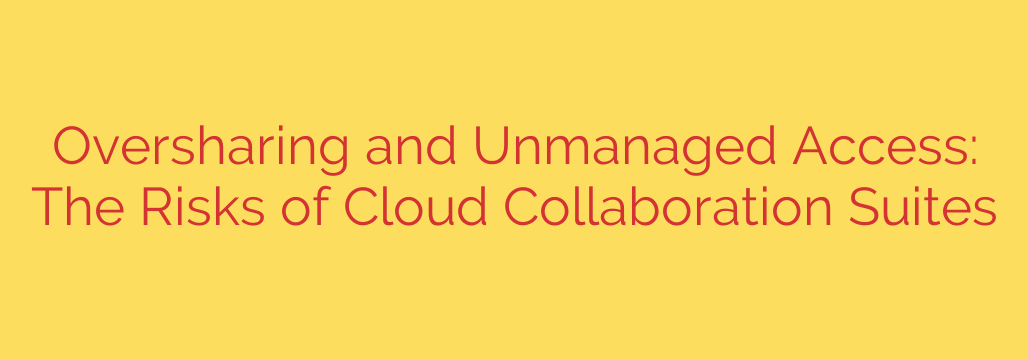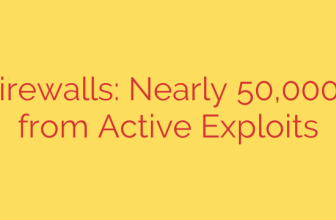
The Collaboration Paradox: How Your Team’s Favorite Tools Create Major Security Risks
In today’s fast-paced business world, cloud collaboration suites like Microsoft 365 and Google Workspace are not just helpful—they are the central nervous system of productivity. They allow teams to share ideas, co-author documents, and move projects forward with incredible speed. But this same seamless collaboration hides a significant and often overlooked security vulnerability.
The very features that make these platforms so powerful—effortless sharing and universal access—can also become your organization’s weakest link if not managed properly. Many businesses are inadvertently exposing sensitive data through two common but dangerous practices: digital oversharing and unmanaged access.
The Hidden Danger of “Anyone with the Link”
Oversharing is the digital equivalent of leaving confidential files on a public bench. It happens when employees, often with the best intentions of being efficient, set sharing permissions too broadly. The most common culprit is the seemingly harmless “anyone with the link can view/edit” setting.
While convenient for sharing a non-sensitive presentation, this practice becomes a serious threat when applied to documents containing financial data, customer information, intellectual property, or strategic plans. Once that link is shared, you lose all control over it. It can be forwarded, posted in a public forum, or accessed by former employees, creating a permanent data leak.
The core problem is that the ease of sharing often overrides security diligence. In the rush to complete a task, employees default to the quickest sharing method, unaware that they may be creating a critical security gap.
Access Creep: The Silent Threat That Grows Over Time
Even more insidious than oversharing is the problem of “access creep.” This occurs when user permissions and access rights accumulate over time without ever being reviewed or revoked.
Think about the entire lifecycle of an employee or contractor:
- An employee moves from the finance department to marketing but retains access to sensitive financial folders.
- A contractor is given access to a project folder and, months after the project is finished, their access is never revoked.
- A team member leaves the company, but their account isn’t properly de-provisioned, leaving them with lingering access to shared drives and documents.
Each of these instances creates a “ghost” permission—an unnecessary and unmonitored point of access. Over years, an organization can accumulate hundreds or even thousands of these outdated permissions. Outdated permissions create a ghost network of potential security threats within your system, accessible to former employees, third-party vendors, and potentially malicious actors who compromise an old account.
The Real-World Consequences
Ignoring these issues isn’t an option. The consequences of unmanaged cloud collaboration can be severe and far-reaching.
- Data Breaches: A single public link to a sensitive file can lead to a significant data breach, exposing customer PII (Personally Identifiable Information), trade secrets, or internal financial reports.
- Compliance Violations: For industries governed by regulations like GDPR, HIPAA, or CCPA, improper data handling can result in massive fines and legal penalties. A lack of control over who can access personal data is a direct violation of these mandates.
- Intellectual Property Theft: Competitors or malicious actors can exploit loose permissions to steal proprietary information, product roadmaps, and research data, eroding your competitive advantage.
- Reputational Damage: A public data leak can destroy customer trust, damage your brand’s reputation, and have long-term financial repercussions.
Actionable Steps to Secure Your Collaboration Environment
Securing your cloud suite doesn’t mean hindering productivity. It means establishing clear, proactive policies that enable safe collaboration. Here are essential steps every organization should take:
Enforce the Principle of Least Privilege (PoLP): This is the foundational rule of access management. Users should only be granted the minimum level of access required to perform their job functions. An engineer shouldn’t have access to HR files, and a marketing intern doesn’t need access to the company’s master financial records.
Conduct Regular Access Audits: Don’t let permissions go unchecked. Make access reviews a mandatory, recurring task. At least quarterly, department heads should review who has access to their team’s critical files and folders and revoke any unnecessary permissions.
Automate Onboarding and Offboarding Processes: Human error is a major factor in access creep. Integrate access management directly into your HR processes. When an employee joins, changes roles, or leaves, their permissions should be automatically granted, modified, or revoked as part of a standardized workflow.
Train Your Employees on Secure Sharing: Your team is your first line of defense. Educate employees on the risks of oversharing. Teach them when it’s appropriate to use a public link versus sharing with specific, named individuals. Discourage the use of personal accounts for work and provide clear guidelines for handling sensitive data.
Utilize Built-in Security Tools: Platforms like Microsoft 365 and Google Workspace have powerful built-in tools for data loss prevention (DLP), access alerts, and data classification. Configure and actively monitor these tools to automatically flag or block the improper sharing of sensitive information, such as credit card numbers or social security numbers.
Cloud collaboration tools are essential for the modern workplace, but their benefits should not come at the cost of your security. By understanding the risks of oversharing and access creep and implementing a robust governance strategy, you can turn a potential liability back into your organization’s greatest productivity asset.
Source: https://go.theregister.com/feed/www.theregister.com/2025/09/30/tmi_how_cloud_collaboration/








